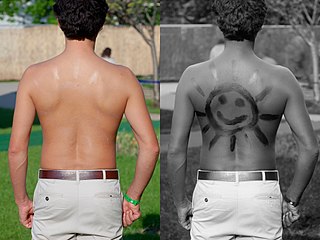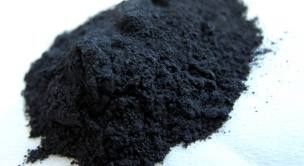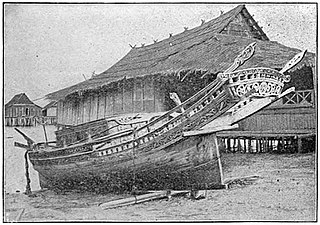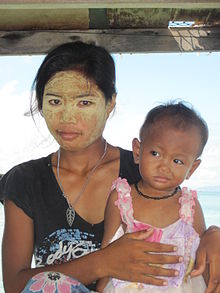
Cosmetics are constituted mixtures of chemical compounds derived from either natural sources, or synthetically created ones. Cosmetics have various purposes. Those designed for personal care and skin care can be used to cleanse or protect the body or skin. Cosmetics designed to enhance or alter one's appearance (makeup) can be used to conceal blemishes, enhance one's natural features, add color to a person's face, or change the appearance of the face entirely to resemble a different person, creature or object. Due to the harsh ingredients in makeup products, individuals with acne-prone skin are more likely to suffer from breakouts. Cosmetics can also be designed to add fragrance to the body.

Sunscreen, also known as sunblock or sun cream, is a photoprotective topical product for the skin that helps protect against sunburn and most importantly prevent skin cancer. Sunscreens come as lotions, sprays, gels, foams, sticks, powders and other topical products. Sunscreens are common supplements to clothing, particularly sunglasses, sunhats and special sun protective clothing, and other forms of photoprotection.

Mehndi is a form of temporary skin decoration using a paste created with henna. In the West, mehndi is commonly known as henna tattoo, although it is not actually a tattoo as only the surface of the skin is inked.

Sindoor is a traditional vermilion red or orange-red coloured cosmetic powder from the Indian subcontinent, usually worn by married women along the part of their hairline. In Hindu communities the sindoor is a visual marker of marital status of a woman and ceasing to wear it usually implies widowhood.

Okir, also spelled okil or ukkil, is the term for rectilinear and curvilinear plant-based designs and folk motifs that can be usually found among the Moro and Lumad people of the Southern Philippines, as well as parts of Sabah. It is particularly associated with the artwork of the Maranao and Sama (Badjao) tribes, although it can also be found to a lesser extent among the Maguindanao, Iranun, Tausug, Yakan, and Lumad groups. The design elements vary among these ethnic groups, with the greatest refinement being found among the Maranao.

Kohl (Arabic: كُحْل, romanized: kuḥl), kajal or kajol is an ancient eye cosmetic, traditionally made by grinding stibnite (Sb2S3) for use similar to that of charcoal in mascara. It is widely used in the Middle East, Caucasus and North Africa, South Asia, West Africa, and the Horn of Africa as eyeliner to contour and/or darken the eyelids and as mascara for the eyelashes. It is worn mostly by women, but also by some men and children. The content of kohl and various ways to prepare it differ based on tradition and country. Several studies have questioned the safety of kohl due to the dangers of lead poisoning.

Sitangkai, officially the Municipality of Sitangkai, is a 1st class municipality in the province of Tawi-Tawi, Philippines. According to the 2020 census, it has a population of 37,319 people.

The Sama-Bajau include several Austronesian ethnic groups of Maritime Southeast Asia. The name collectively refers to related people who usually call themselves the Sama or Samah ; or are known by the exonym Bajau. They usually live a seaborne lifestyle and use small wooden sailing vessels such as the perahu, djenging (balutu), lepa, and vinta (pilang). Some Sama-Bajau groups native to Sabah are also known for their traditional horse culture.

Thanakha is a paste made from ground bark. It is a distinctive feature of the culture of Myanmar, seen commonly applied to the face and sometimes the arms of women and girls, and is used to a lesser extent also by men and boys.

The vinta is a traditional outrigger boat from the Philippine island of Mindanao. The boats are made by Sama-Bajau, Tausug and Yakan peoples living in the Sulu Archipelago, Zamboanga peninsula, and southern Mindanao. Vinta are characterized by their colorful rectangular lug sails (bukay) and bifurcated prows and sterns, which resemble the gaping mouth of a crocodile. Vinta are used as fishing vessels, cargo ships, and houseboats. Smaller undecorated versions of the vinta used for fishing are known as tondaan.

The history of cosmetics spans at least 7,000 years and is present in almost every society on earth. Cosmetic body art is argued to have been the earliest form of a ritual in human culture. The evidence for this comes in the form of utilised red mineral pigments including crayons associated with the emergence of Homo sapiens in Africa. Cosmetics are mentioned in the Old Testament—2 Kings 9:30 where Jezebel painted her eyelids—approximately 840 BC—and the book of Esther describes various beauty treatments as well.

Foundation is a liquid, cream, or powder makeup applied to the face and neck to create an even, uniform color to the complexion, cover flaws and, sometimes, to change the natural skin tone. Some foundations also function as a moisturizer, sunscreen, astringent or base layer for more complex cosmetics. Foundation applied to the body is generally referred to as "body painting" or "body makeup".

Face powder is a cosmetic product applied to the face to serve different functions, typically to beautify the face. Originating from ancient Egypt, face powder has had different social uses across cultures and in modern times, it is typically used to set makeup, brighten the skin and contour the face. Face powders generally come in two main types. One of which is loose powder, which is used to assist with oily skin in absorbing excess moisture and mattifying the face to reduce shininess. The other is pressed powder which conceals blemishes and maximises coverage.

The Sama–Bajaw languages are a well-established group of languages spoken by the Sama-Bajau peoples of the Philippines, Indonesia and Malaysia.
Cosmetics, first used in ancient Rome for ritual purposes, were part of daily life. Some fashionable cosmetics, such as those imported from Germany, Gaul and China, were so expensive that the Lex Oppia tried to limit their use in 189 BCE. These "designer brands" spawned cheap knock-offs that were sold to poorer women. Working-class women could afford the cheaper varieties, but may not have had the time to apply the makeup as the use of makeup was a time-consuming affair because cosmetics needed to be reapplied several times a day due to weather conditions and poor composition.

Lepa, also known as lipa or lepa-lepa, are indigenous ships of the Sama-Bajau people in the Philippines and Malaysia. They were traditionally used as houseboats by the seagoing Sama Dilaut. Since most Sama have abandoned exclusive sea-living, modern lepa are instead used as fishing boats and cargo vessels.

Bangka are various native watercraft of the Philippines. It originally referred to small double-outrigger dugout canoes used in rivers and shallow coastal waters, but since the 18th century, it has expanded to include larger lashed-lug ships, with or without outriggers. Though the term used is the same throughout the Philippines, "bangka" can refer to a very diverse range of boats specific to different regions. Bangka was also spelled as banca, panca, or panga in Spanish. It is also known archaically as sakayan.

Masonjoany is a cosmetic paste and sunscreen made of ground wood. It is worn as a protective and decorative mask by women and girls in Madagascar, Comoros, and Mayotte. In Madagascar, the paste has yellow and white forms, with yellow masonjoany being derived from the wood of the tabàky or Madagascar sandalwood, and white masonjoany deriving from the wood of the aviavy or fihamy tree. The wood is ground against a surface of ceramic, stone, or coral skeleton, and combined with water and oil to make the paste. A study of masonjoany in Comoros recorded thirty-nine plant species in use to make the paste, the most common being Indian sandalwood. The practice in Madagascar originates from cultural exchange between Malagasy natives and Indian merchants in Nosy Be.

















